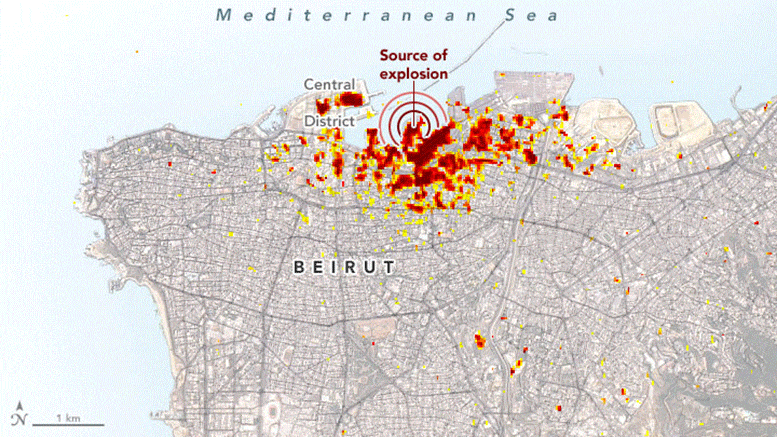Tears For Lebanon


by John J. Metzler
Weirs Times Contributing Writer
The massive double blast which rocked Beirut harbor brought near cataclysmic damage to the Lebanese capital. Yet as the dust settled on this tragedy, with 200 dead and 5,000 injured, the political and economic reverberations of the explosion have shaken Lebanon to the core and threatened to turn the former oasis of relative stability into yet another Middle Eastern morass.
Though a myriad of macabre conspiracy theories understandably swirl around this catastrophe, it appears that the double blast, one of which produced a sinister mushroom cloud, came from a massive cache of improperly stored ammonium nitrate fertilizer. Some 2,750 tons of the stuff was off-loaded six years ago from an impounded Moldovan merchant ship the “Rhosus” and was then carelessly forgotten about. The least you can say is that frightful incompetence and slipshod security led to a mega blast devastating the port shattering windows and buildings around the city and displacing 300,000 people from their homes.
But there’s more. Lebanon was in the final stages of a controversial trial over the Syrian- implicated assassination of former Prime Minister Rafik Hariri by a massive bomb blast on Beirut’s fashionable waterfront in 2005. A U.N. backed tribunal trying four suspects from the Shi’ite Hezbollah movement was due to issue a verdict just days after the blast.
Lebanon is plagued by a crisis of endemic political corruption, a financial meltdown from debt and currency devaluation, and a massive refugee spillover from neighboring Syria’s conflict. Let’s be blunt, the roots of many of Lebanon’s troubles go back to Syria’s occupation of Lebanon between 1975-2005 under the nationalist rubric Greater Syria.
Equally the Hezbollah terrorist movement, a political cat’s paw of Iran has been entrenched in south Lebanon for a generation threatening neighboring Israel. Now Hezbollah militants share political power in the Beirut government. Curiously Hezbollah controls sectors of the port of Beirut and border crossings
Since October 2019 massive political demonstrations have rocked the small country protesting corruption and incompetence and demanding the resignation of the entire political class. Many media outlets now sadly say Lebanon risks becoming a “failed state.” Reality may be reasserting itself through the churning strife characterizing the region.
Beirut was once known as the Paris of the Middle East owing to its French architecture, language and lifestyle. Lebanon became a cosmopolitan moderate middle class land in the midst of mayhem. That was long ago.
Sectarian faultiness crisscross this multi-religious land. The historic power sharing accord between Christians and Muslims continues but with Hezbollah’s hand on the scales of power.
According to the independent Statistics Lebanon, estimates are 68 percent of the population is Muslim (32 percent Sunni, 31 percent Shia, and Alawites). Approximately 32 percent of the population remains Christian, (Orthodox, Maronite, Catholic).
Indeed over the past generation, Lebanon has sadly reflected the region; a civil war from 1975-1990, the gaggle of lethal ethnic militias, endemic kidnappings, car bombs and the 1983 suicide bombing of the U.S. Marine barracks.
By 2005, the peaceful “Cedar Revolution” strove to regain Lebanon’s impinged sovereignty, calling for general elections free from Syrian interference. The Syrian army later withdrew its troops from Lebanon in April after 30 years of illegal occupation.
To a degree things stabilized politically for the better and the country revitalized for renewed tourism and commerce. But the Syrian war saw more than a million refugees pouring into a small country, and the COVID-19 pandemic, has sadly reset the recovery back to start.
Though Lebanon’s total population stands at 5.8 million, the United Nations High Commissioner for Refugees (UNHCR) estimates this includes 4.5 million citizens and approximately 1.3 million refugees fleeing the conflicts in Syria and Iraq.
So what must be done?
France, the former colonial power, dispatched emergency aid not to mention a lightning visit by President Emmanuel Macron who said a “new political order” was needed in Lebanon.
The United Nations and France co-sponsored an unprecedented pledging conference for Lebanon’s relief and renewal raising $300 million. The UN ramped up humanitarian aid bringing its funding for this crisis to $15 million, European Union $70 million and Qatar $50 million.
The USA initiated a humanitarian airlift in from the Persian Gulf. President Donald Trump has underscored the importance of Lebanese humanitarian assistance pledging $15 million in aid.
Significantly, both Presidents Macron and Trump called for “an impartial, credible and independent inquiry,” into what happened in Beirut. Transparency is so important. Macron warned, “It is the future of Lebanon, its people and the region which are in play.” We must not let Lebanon die.
John J. Metzler is a United Nations correspondent covering diplomatic and defense issues. He is the author of Divided Dynamism The Diplomacy of Separated Nations: Germany, Korea, China.
